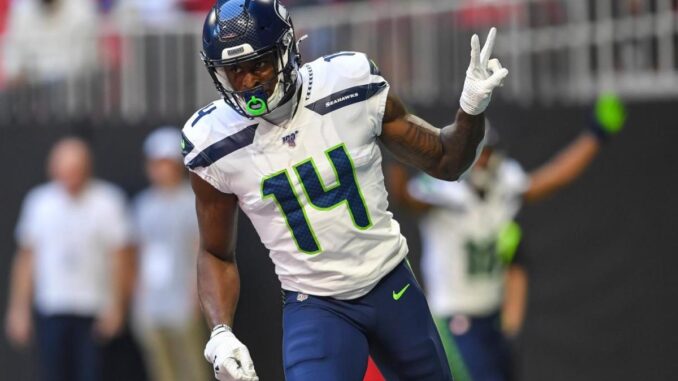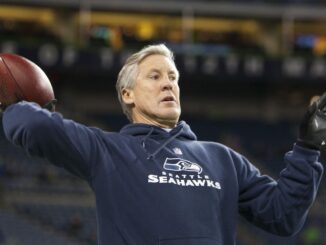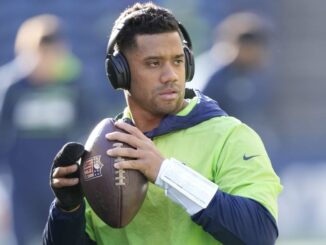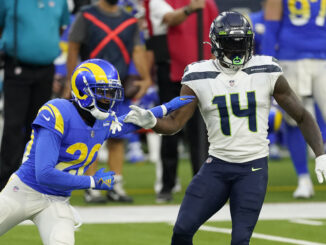
Well, shoot. The Seattle Seahawks finished their 2021 season much in the way they began, producing more than enough big plays to outlast their opponent while playing on the road. Seattle was 2-0 in games that either began or ended their season, and just 6-9 the rest of the way – with QB Russell Wilson missing three of those contests.
If you pace Wilson’s week one and week 18 stats for the entire season (at least the 14 games he played), he would have finished with 3,444 yards to go with 49 touchdowns and just 7 interceptions. To give you an idea of how the season went, here is what he finished with –
3113 yards to go with 25 touchdowns and 6 interceptions. He was very close to his yards and interceptions, but he barely made it halfway there in touchdowns.
Some of you might be thinking this was a lost season because of the duration. And while this was the longest season in NFL history in terms of games played, it was the second eighteen-week season for the league. The first took place in 1993 when all teams had a second bye week but only played sixteen games. Seattle finished 6-10 in that season, which is startlingly close to their 7-10 finish this year.
That’s about where the parallels between this season and 1993 end, so you can keep any hope you have that 2022 will be better. It shouldn’t be another 1994, or at least let’s hope not. I’ll save you the trouble and just warn you a repeat of 1994 would be very bad – like 2021 bad.
Before they can flip the switch and move on to next year, Seattle has to look at re-signing at least eight players on offense, as LT Duane Brown, RT Brandon Shell, Center Ethan Pocic, TE Will Dissly, TE Gerald Everet, RB Rashaad Penny, RB Alex Collins, and QB Geno Smith all have expiring deals.
On defense, they need to review new deals for DE Rasheem Green, DT Al Woods, SS Quandre Diggs, CB Sidney Jones, and CB DJ Reed. Diggs had a brutal injury in the win over Arizona last week, and will still command a huge payday in free agency, so he’s likely gone unless Seattle can work some balance sheet magic.
With a projected salary cap in the neighborhood of $208 million, including dead cap and rollover Seattle would have somewhere around $52 million in cap space. That sounds like a lot, but that’s about four million for each player they need to re-sign, and that doesn’t include pay increases or signing any rookies they draft or going after free agents.
Needing to find the money for thirteen impact players is a busy enough offseason for the front office. Still, they also need to review new deals for DE Carlos Dunlap, RB Chris Carson, and WR DK Metcalf, as all three are set to become free agents after next season. Metcalf will get paid big time somewhere; it might as well be in Seattle. Dunlap is on the final leg of his career and might be considering retirement. Carson has repeatedly proven that he cannot stay healthy and cannot be trusted as the starting running back. He’ll be 28 by the time his deal expires, and while he’s still young with low miles, no one knows how many good or healthy years he has left. Metcalf is the only one of the three the team has to make a priority, but he’s going to be one of the top paid receivers in the league, and that’s going to be expensive. For reference, Metcalf currently makes just under $1.5M a season, and the top receivers in the game make at least $10M per year. It’s not going to be easy to come up with an extra $8.5M, but Seattle will have to find it or risk losing their star receiver.
Restructuring and extending contracts can often provide cap relief in the short term as funds are either backloaded or clustered into a bonus that doesn’t count toward this year’s cap. QB Russell Wilson has a cap hit of $37M, nearly $17M more than the next player on the roster, Bobby Wagner, who is set to make $20M. After that, the next player is making just over $10M per year, so if the front office can convince Wilson or Wagner to restructure their deals, it could free up much-needed funds to secure upgrades on the roster.
We can all agree the roster this year was part of the issue along with coaching and player performance; they will need to fix all three if this team is going to put this season in the rearview mirror and avoid repeating it. You can pay your top players as much as you want, but if the guys around them are not playing like stars, it’s usually a sign that you don’t have a balanced roster, and it won’t matter that the average player on your roster makes around $2M per year. You’ll get praised in the part of your performance review that involves the budget especially compared to other franchises, and then you’ll get killed when they review the team’s performance against other teams on the field. A good executive should be getting good scores in both departments. Still, GM John Schneider is not going to look good when he sees the performance of the players he is barely paying, and that it’s dragging down the performance of a guy like Wilson, who he is paying top dollar. Speaking of contracts, Schneider’s own deal is good through 2027, so he’s not going anywhere.
Heading into this season, Scheider was rightfully praised for upgrading the roster with mostly nothing to work with. He changed offensive coordinators, patched up the offensive line, added to the defense, brought in a playmaker at TE, and re-signed some key veterans on both sides while trading draft picks that weren’t likely to benefit them in the short term with an aging QB.
For a team coming off a 12-4 season and a division title, it seemed like Seattle was headed in a great direction. Finishing this season at 7-10, it’s fair to say they did not meet expectations. Perhaps Wilson’s first major injury of his professional career played a part. Still, one player being missing for less than 20% of the games cannot be what derails that entire season, especially if that same player makes the same percentage in the team’s salary cap. Either that player is not earning their paycheck, or management has not put the right players around them. Both can be true, and I believe they are. I think something was off with Russ this year, but I also believe his teammates didn’t pull their weight either.
If we were to give football teams a report card, it might look something like this –
That low of a grade seems fair based on the backward trajectory the team was on for the course of the season, but it looks even fairer when you compare it to how they finished the season last year –
You may recall that the story in Seattle at the end of last season was that they were using a medieval offense that was paired with a defense made of wet paper. To go from a solid “B” of a season and a top 8 offense in scoring and top 10 overall with expectations to compete for a title and instead finish in the top 10 of the draft – that is to say, the bottom ten teams in the league? If we adjust their current grade to include expectations going into the season, they would be receiving an “F,” which makes the “D” they were graded even more reasonable.
How they went from one of the historically worst passing defenses in a passing league to nearly setting bad records again, I don’t know what to say other than it’s unacceptable – especially given their lack of turnover on that side of the ball.
On offense, there are some issues you can point out, and it might not require wholesale changes like they seem to require on defense. Many teams stumble under new coordinators; it’s not usual for a new face to come in with a new playbook and have immediate success. That’s why it’s surprising when it does happen. The first two weeks, Seattle sure looked like they would be an instant success, but the wheels started to come off in the next couple of weeks, and even before Wilson was injured in week five, there were already looming questions. When Wilson returned in week ten and was shut out for the first time in his career, there were even more questions. Wilson swatted away any concerns that he had returned from his injury too quickly and that he just needed to adjust to the time away. His field vision resembled that of an overwhelmed first-time starter. When he did run, he slid headfirst instead of feet first, often bracing himself for impact like it was a button he didn’t mean to press. His throws sailed like the ball was thrown by someone that couldn’t grip the ball properly. When he stayed in the pocket, he didn’t sense danger coming and shifted to throw the ball while he had time; he often waited for a lineman to lose control of a rusher and stumbled around looking for an out. He didn’t just look off; he looked like another person doing a very poor impersonation of Russell Wilson.
Wilson threw 15 fewer touchdowns this season and just seven fewer interceptions, so the perception that he would have performed better if he had been in more games doesn’t add up. He was also sacked just six fewer times, so the upgrades on the offensive line didn’t do much to increase his protection in two fewer games. It wasn’t just Wilson that was the issue.
In an extra game this year, DK Metcalf had almost 400 fewer yards and two fewer touchdowns while averaging three fewer yards per reception. You might say DK was the product of Wilson struggling, but then look at Tyler Lockett, who had more yards this year than last year but caught two fewer touchdowns and actually had the second-largest average per reception in his career.
Whether Wilson’s hand was healthy is no longer a mystery, as he recently stated that he came back sooner than he should have. But what about his legs? Wilson hasn’t run the ball fewer than 67 times in a single season in his career, and yet this year, he attempted just 43 for one of the lowest averages of his career. For comparison, he attempted 83 rushes last season. Were the holes just not there this year, or is Wilson’s athleticism on the decline? It’s hard to imagine Wilson rushing 40 more times if he had played in two more games, but it’s possible he could have reached his previous career low, although even that seems unlikely. He averages just over five attempts per game, so even if he doubles that, he’s not getting there. Let’s just assume that Russ felt off all season, and it wasn’t just the hand.
Year two of a new scheme often brings better results, so we’ll see if Russ and company can get cooking early on next season. With Russ holding the no-trade card in his contract and the team seemingly interested in keeping him, it’s not likely Russ will be playing for another team any time soon. However, Russ was less than upfront with the media when asked if he wanted to stay in Seattle. His somewhat veiled response led to an interpretation that he would leave if the right team was interested, and he didn’t feel Seattle was making the proper adjustments. With a limited bag of cash and fewer and fewer players seeing Seattle as a contender, it’s a long shot they will get a chance to sign the best free agents this spring.
Wilson will turn 34 next year, and while he appears to have plenty left in the tank, it’s anyone’s guess how many prime years he has left. Wilson has only shown minimal signs of wear and tear, but remember that guys like Tom Brady and Warren Moon are the outliers when it comes to career duration, not the standard. With a title drought now at eight years – and a seven-year absence in the conference championship – one must wonder how many years he will spend here without a complete team around him and a chance to win Super Bowls.
When speaking to the media following their win over Arizona last week, Wilson said he intends to win Super Bowls, and he hopes that’s in Seattle. But ask yourself this – do you see a Super Bowl roster here? If the answer is no, then unless you see wholesale changes from management, we have to assume this isn’t a super bowl team. That’s not to say it’s not a talented roster, but there are a lot of talented teams out there not competing for championships.
Wilson might be able to get more out of himself and his teammates next year. We’ll have to wait and see if they can pull off one of the more impressive turnarounds in recent memory. If they can’t, they certainly won’t be competing for a championship next year. This was Wilson’s first losing season in the NFL and just the second time he has missed the playoffs. Let’s hope we don’t see either of those become a trend.




